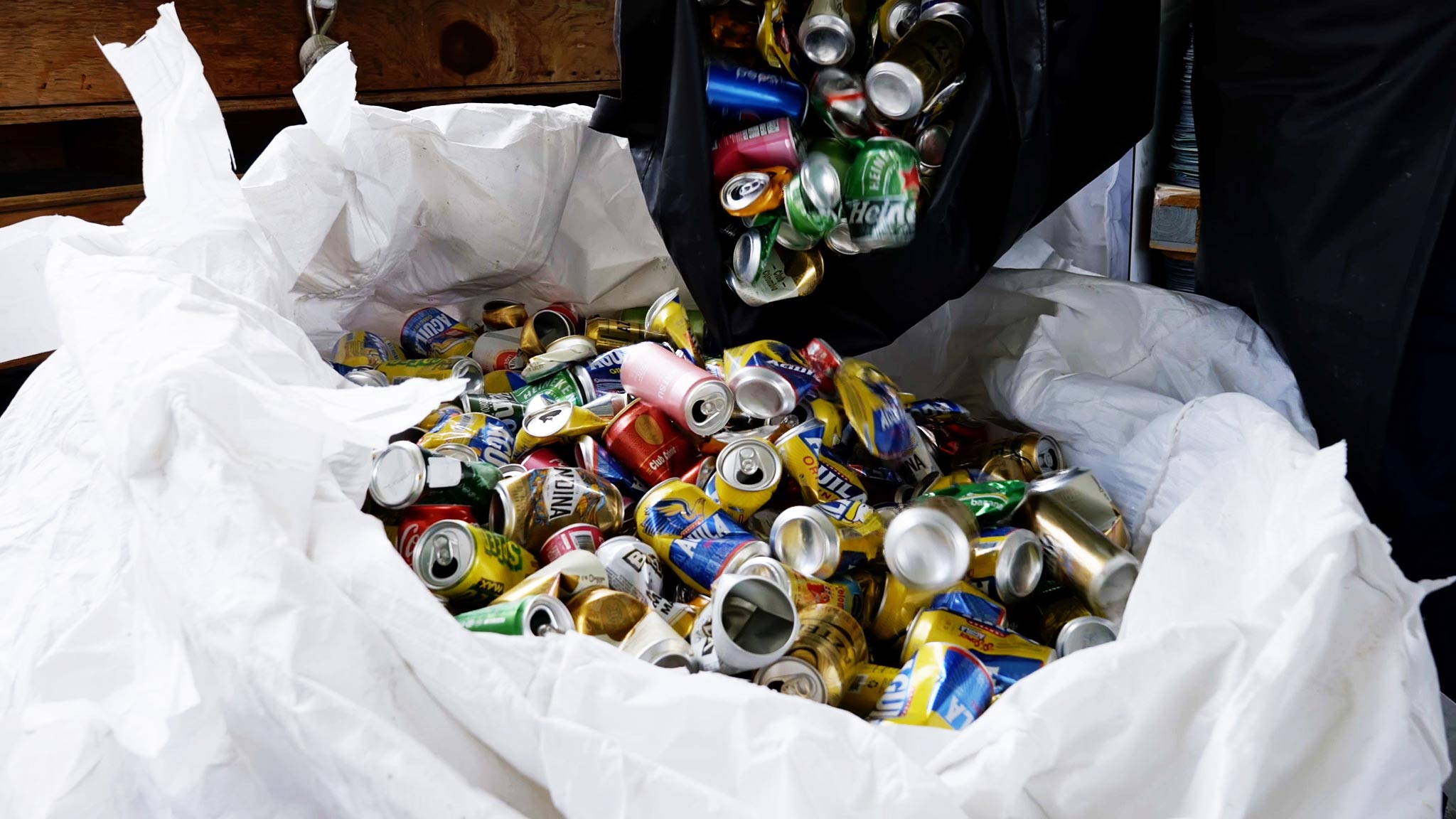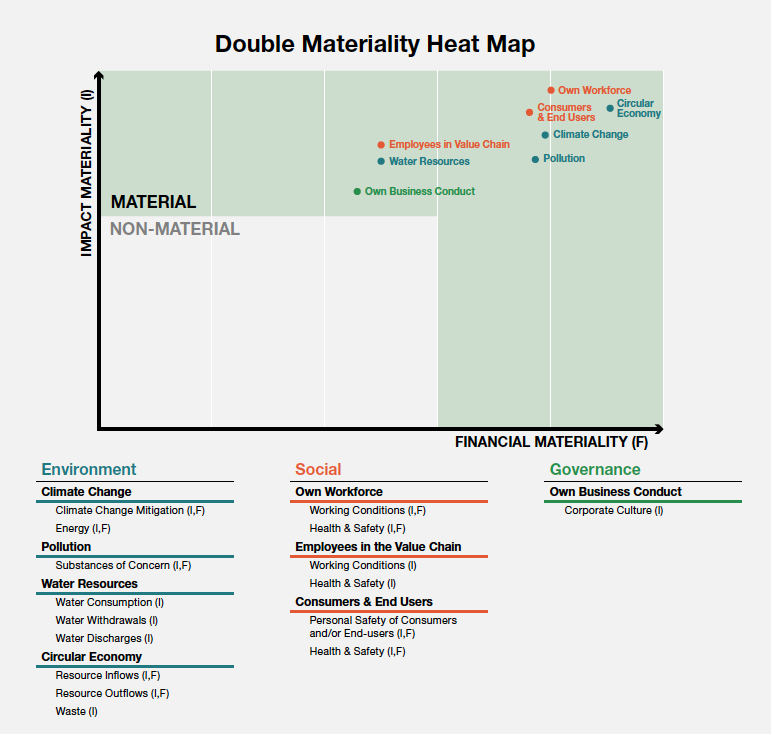Materiality

Setting the Stage for Reporting
In accordance with the Global Reporting Initiative’s (GRI) guidelines, we aim to produce a formal Sustainability Materiality Assessment every two years, as the exercise helps establish a set of sustainability-related focus areas that are of interest to our stakeholders and that intersect with our business.
Our most recent assessment was completed in 2024. We used a double materiality framework, evaluating both the financial impact of environmental, social, and governance issues on our organization and the impact of our activities on society and the environment. This approach ensures we identify and prioritize the topics most relevant to our stakeholders and long-term business resilience.
Our process of conducting a Sustainability Materiality Assessment includes the following stages:
1. Identification
1. Identification
Proper preparation and scoping are critical for a useful double materiality assessment (DMA). This includes value chain mapping to identify upstream and downstream sectors and sub sectors, establishing assessment boundaries and thresholds, and mapping internal and external stakeholders to determine their involvement. All business units of Crown Holdings, Inc. are considered for these assessments.
For each assessment, we update and fine-tune our process to reflect any notable changes since our last report, including:
- Significant changes in our business, such as acquisitions and divestitures
- Alignment with GRI Standards and other relevant frameworks, reporting via the latest reporting guidance offered
- Other changes related to our business, customers, public policy, the context in which we do business and the evolving expectations of key stakeholders
2. Evaluation
2. Evaluation
An independent third party conducts interviews with identified key stakeholders, assesses reports outlining environmental, social and governance stakeholders for the industry, and analyzes our business plans, strategies and key risk assessments. They also benchmark industry peers and enterprise customers. Topic-specific validation workshops were conducted to confirm which IROs were material from an impact and/or financial perspective.
Interviews and value chain workshops identified and mapped potential impacts, risks and opportunities (IROs) related to potentially material sustainability topics. Details were confirmed through correspondence with internal subject matter experts.
Stakeholders considered in the evaluation process:
- Customers
- Employees
- Investors
- Suppliers
- Communities and their representatives
- Consumers and their representatives
- Environment and their representatives
- Workers in the value chain
- Governments
- Industry bodies
- NGOs and advocacy groups
3. Assessment
3. Assessment
Our Twentyby30TM program was informed by core sustainability topics in line with material issues identified through previous materiality assessments. The most recent DMA confirmed that these are still considered critical by our stakeholders. We will continue to focus on these areas as most critical to manage:
- Energy & Carbon Footprint
- Water Management & Scarcity
- Waste Reduction & Management
- Employee Health, Safety & Wellness
- Product Quality & Safety
- Business Ethics
Material Topics at a Glance
As climate, social and governance risk are ever-evolving, materiality assessments will continue to serve as a guide for the Company in determining issues that are most relevant to all stakeholders. This also helps to assess our progress toward our targets and recognize opportunities in how the Twentyby30TM program aligns with the goals of our customers and other industry partners.
Our Twentyby30TM program has been informed by previous materiality assessments and still aligns with the findings of our most recent 2024 Double Materiality Assessment.
Each material topic identified is covered under a specific pillar and goal of Twentyby30TM. For each goal, we have identified several actions at business and plant levels which we monitor on a regular basis and report annually in our sustainability report.
Engagement with our key stakeholders has led us to develop more collaborative initiatives in order to grow our impact, namely related to collection and recycling of our packaging, and our engagement with our raw materials suppliers to support decarbonization pathways throughout the value chain. Crown’s Corporate culture and robust governance are instrumental to drive our program forward and deliver on our actions.
1. Top Priority Topics
1. Top Priority Topics
Business Practices
- Business ethics & good governance
- Compliance with ESG rules, regulations standards
- Data & information security risk management
Products
- Product quality, safety (including food safety) & stewardship
- Cost reduction, including operational excellence, efficiency & lightweighting
Customers
- Customer satisfaction
- Compliance with environmental(chemical, waste,recycling) legislation applicable customers & our industry
- Support for the sustainability goals of our customers
- Alignment with customers on sustainability/ customer partnerships & dialogue
Employees
- Employee health, safety & well-being
- Inclusive working climate
- Employee social relations
- Development needs
- Career growth
- Professional & social engagement
- Diversity & Inclusion
Circularity & Waste
- Circular Product Lifecycle Management e.g., % raw materials from
a) recycled content,
b) renewable resources,
c) renewable & recycled content; revenue from products that are reusable, recyclable and/or compostable; reducing lifecycle impact - Business model, product & process innovation
- Improvement in the recycling rate & recycled content of metal packaging
- Supplier, customer & consumer education on the recyclability of metal packaging
- Waste reduction
Energy & Carbon Footprint
- Carbon/greenhouse gas emissions (GHG)
- Total energy consumption
- Energy & carbon intensity
- Renewable energy
2. High Priority Topics
2. High Priority Topics
Sourcing
- Supplier Code of Conduct adherence
- Responsible supply chain management (e.g., resource traceability, identify & manage materials & chemicals, optimized logistics, percent of certified aluminum purchased)
- Responsible sourcing assessment
Resources
- Resource scarcity (managing & helping to preserve key inputs that may be under threat by environmental conditions, political instability, economic instability or other)
- Locally sourced inputs
Water & Air
- Water management & risks
- Air emissions (VOCs, particulate matter (PM), NOx, etc.) reduction
3. Priority Topics
3. Priority Topics
Communities
- Community support to enhance well-being
- Investment & engagement with local communities & non-profits
- Community engagement by employees

What's new in the DMA list?
|
|
|
|
|
|
|
|
|
|
|
|
|
|
|
|
|
|